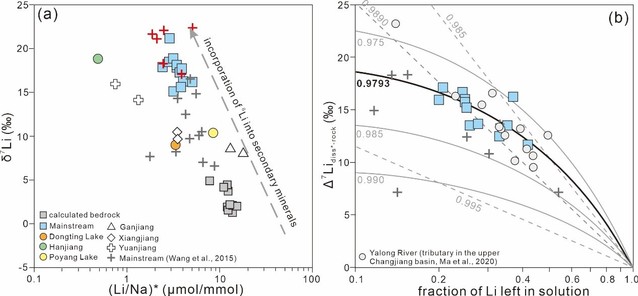Chengfan Yang a, *, Jiacheng Peng a, Junjie Guo a, Qiang Hao b, Jinniu Chen a, Shouye Yang a
a State Key Laboratory of Marine Geology, Tongji University, Shanghai 200092, China
b The Engineering & technical College of Chengdu University of Technology, Leshan 614000, China
Abstract:
Lithium (Li) isotopes have been extensively studied as a key proxy for silicate weathering. However, our understanding of Li isotope fractionation in lowlands and/or floodplains, particularly regarding authigenic phases, needs further refinement. In this study, we present comprehensive geochemical data, including elemental, ionic concentrations, as well as lithium and strontium (Sr) isotopic compositions, obtained from river water, suspended particulate matter (SPM), and associated oxyhydroxide fractions collected across the mid-lower Changjiang basin. The dissolved δ7Li values (+8.4‰ to +17.1‰) contrast with suspended particulate matter (SPM: −2.7‰ to −0.3‰) and its oxyhydroxide fraction (−15.9‰ to −7.0‰), revealing significant isotope fractionation during secondary phase formation. An inverse mixing model identifies silicate weathering (50.5 ± 4.9%) and evaporite dissolution (35.4 ± 4.0%) as the dominant sources of the dissolved Li, followed by urban sewage contributions of 10.4 ± 1.5%. After correcting for non-silicate sources, dissolved δ7Li values conform to a steady-state batch fractionation model, reflecting the dynamic balance between primary mineral dissolution and secondary mineral (mainly clays) formation. The nearly consistent 87Sr/86Sr ratios of SPM oxyhydroxide fraction with those of river water strongly demonstrate their authigenic precipitation within the riverine environment. We further infer that the formation of authigenic oxyhydroxide likely played a significant role in fractionating Li isotope in the geological past, albeit secondary to clays. However, in the context of intense dam constructions, their impacts cannot be easily observed in modern river lowlands/floodplains due to reduced SPM concentrations. According to the updated global average, we hypothesize that floodplains exert little influence on elevating riverine δ7Li values, at least in present-day river basins surrounding the Tibetan Plateau. These findings refine our understanding of river chemistry in a highly-populated river basin, highlighting authigenic processes as a potential control on Li isotopes, warranting re-evaluation in high erosion and free-flowing river systems.
Full article:https://www.sciencedirect.com/science/article/pii/S0016703725004752?dgcid=author


